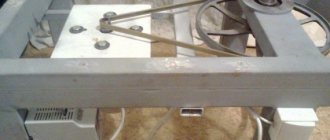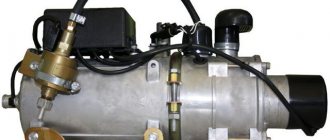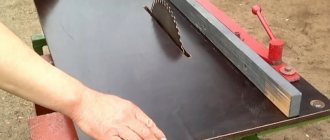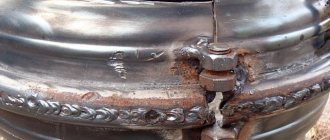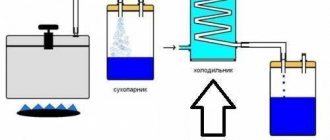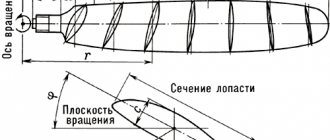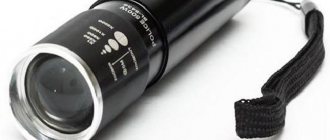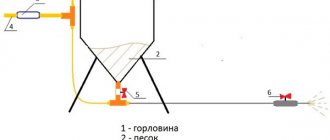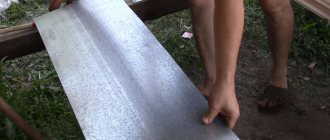A do-it-yourself boat made from PVC pipes is a simple design.
Its production will cost very little, but you can get a lot of pleasure during the summer swimming season. You can make such a structure from plastic materials yourself. It's not a difficult job. PVC pipe is the most convenient option for constructing products with your own hands. These products are perfectly held together using glue or soldering.
Even if the boat gets damaged during use, there is no need to be upset. Such repairs on your own will not be difficult. Using the same glue, simply apply a patch to the damaged area.
To what has been said, it must be added that building such a boat with your own hands is a very interesting job.
It is recommended to start making a boat with the selection of a drawing. Based on them, the most convenient design is selected.
It’s a good idea to first make patterns of reduced sizes and glue such a structure from ordinary plastic bags. With this kind of work, you can “feel” the material, which means that working with full-scale sizes will be much easier.
After working out the patterns, they are increased proportionally. Craftsmen advise checking the compatibility of the workpieces by making the structure in natural dimensions from polyethylene.
This will, of course, take extra time, but it will be worth it. If any errors were made in the calculations, this will be clear at the initial stage, and there will be no need to spoil expensive materials.
Polypropylene is the optimal material for building a homemade boat
A sheet material currently widely used for the manufacture of swimming pools and various containers, polypropylene is excellent for making a vessel.
According to some characteristics, a boat made of plastic is in no way inferior to a real boat made of aluminum or fiberglass, and may even surpass it. Making a boat that is comfortable for two people will take only 1-2 weeks and you will have at your disposal a full-fledged vessel for fishing or riding.
The advantages of polypropylene, and, accordingly, of a floating device made on its basis, are:
- 100% waterproof;
- zero adhesion;
- resistance to mechanical damage and various types of influences;
- ease of repair;
- the ability to maintain the original appearance for a long time;
- resistance to ultraviolet radiation and to any climatic conditions;
- light weight of the finished product, which is convenient for transportation;
- excellent frost resistance, which simplifies the issue of storing a floating device;
The flexible material very gently absorbs shock and noise, which reduces any instability to a minimum, and therefore guarantees safe movement through water.
Polyethylene boats, what is their advantage
Polyethylene boats, what kind of miracle is this? – I thought, and went further towards off-road equipment.
Then, after some long time, I became interested in this topic and found old photographs of the Liman 350
produced by the Methodius company. I talked with specialists and with people who have such boats in operation. Here's what I learned:
The material for the boats is three-layer LLDPE sandwich polyethylene - durable, elastic, and has positive buoyancy.
LLDPE
– (Linear Low Density Polyethylene) Linear low density polyethylene. Occupies an intermediate position between LDPE and HDPE polyethylenes. Its structure is similar to high-density polyethylene, but it has a number of distinctive advantages: high softening temperature, chemical resistance, and several times higher resistance to tearing and punctures.
To a frequently asked question: What do a home basin and a polyethylene boat have in common?
The manufacturer answers honestly - only the name of the material. The production technology and the resulting final structure of the material are completely different.
A polyethylene boat consists of three layers: An outer, thicker and more durable layer of LLDPE; Internal, thinner layer of LLDPE; Interlayer space, which is filled with foamed polyethylene.
The result is a very light and strong boat. For example, boat Liman 350
weighs only
65 kilograms
!
Advantages of a polyethylene boat:
Due to the light weight of the boat, one person can handle it. No trailer required for transportation, 65 kg. Can withstand any car roof rack. Does not require registration with GIMS.
The boat is manufactured using seamless technology, which gives it maximum strength.
Scratches on the boat are not visible because the material is painted throughout the body and not just on the outside.
The surface of the boat does not become moldy, does not rot, and the boat is not susceptible to corrosion. ( not overgrown with shells
)
Due to better gliding, fuel savings are achieved. ( compared to rubber boats, they say 2 times
)
The reason why everyone loves polyethylene products is their maintainability! Any damage to the boat can be repaired using a gas soldering iron or a hair dryer.
Polyethylene boats are less dangerous because they do not have sharp corners or burrs.
Boats made using sandwich technology have positive buoyancy and are capable of carrying a load when completely filled with water.
Polyethylene is not of interest to scrap metal collectors. Such a boat will certainly not be stolen in order to be taken to a metal collection point.
Many are rightly concerned about the effects of ultraviolet radiation on the material of the boat. But the manufacturer assures that in production it uses the most modern 8th generation UV stabilizers.
To avoid deformation of the hull from heating by the sun, it is recommended to store the boat in an inverted position with bars placed under the sides - they will provide the necessary ventilation.
So neither frost nor sun is scary for a PE boat. The company even claims a boat lifespan of over 50 years.
!
Technical characteristics of the boat Liman 350
Length: 3.55 m; Width: 1.35 m; Side height: 0.43 m; Transom height: 38 cm; Weight 65 kg (!); Load capacity: 300 kg; Passenger capacity: 4 people; Color: green, red, yellow; Maximum motor power: 10 hp. with a total load of 250 kg and a transom load of no more than 30 kg;
Can be equipped with oar oars and transport wheels.
Speed measurements available
(from manufacturer): At 5 hp. and 1 person – 30 km/h At 5 hp. and 2 people – 24.5 km/h At 10 hp. and 1 person – 37-39 km/h At 10 hp. and 2 people – 35 km/h At 15 hp. and 1 person – 43-45 km/h At 15 hp. and 2 people – 42 km/h
Traditionally, “everything is fine” with the manufacturer. But is it really so? Reviews from boat owners can help us here:
- Liman 350. I took it for fishing on a shallow river without big waves. Completes its task completely. But on a wave from a passing boat it can be quite scary. With a 9.8 hp engine. flies (with two men), gets on glide instantly.
- I have been using Liman 350 for 2 years now. There are several observations, first the disadvantages: 1. The weaker sex. Even with small ripples there is vibration. When you switch to another jar, the vibration goes away. 2. When well loaded, the boat gets overwhelmed by a strong wave. 3. The transom under the four-stroke Mercury 5 was raised to the level, otherwise getting on the plank would be difficult and there would be a big rooster behind the stern. After lifting everything is fine, there is no rooster. Pros: The most important thing is glide. When it was calm, I reached 28-29 km/h. When fully loaded, over 10 km of travel, it consumed less than 1 liter of gasoline. (haven't played with screws yet)
- The Liman 350 boat is not a keel boat, it has trimaran bottom contours, and the side height is 43 cm. It is not designed for large waves. If you go against the wave at high speeds, a dolphin factor may arise, but this depends on the load and the motor. You can stand in a boat, throw a spinning rod easily, and move around the same way.
- I bought Liman 350. Good parameters (not all), normal price. The main requirement is a shallow water boat. During operation, it became clear that it was necessary to strengthen the bottom and raise the sides. After sea trials under Yamaha 9.9 at one 42 km/h. After strengthening the bottom of the boat, sea trials showed that the vibration was gone. This increased comfort and speeded up planing.
Taking into account the accumulated experience and wishes of people, in 2022 Methodius carried out a restyling of the Liman-350 model.
In the new modification, the rigidity of the bottom is further strengthened with an aluminum pipe. Due to greater rigidity, it was possible to improve the speed characteristics of the boat.
The boat now has two seats with lockers and one seat with a locker in the bow of the boat hull.
There is an option to equip it with a locker seat with a gas tank: The common compartment is divided into two unequal parts: 1/3 is used for fuel and 2/3 for things. Seats-lockers can be moved relative to the hull of the boat, and for carrying they can be removed altogether.
Tools and materials
Now more about the independent production of a boat:
- polypropylene sheets 5 mm thick - a total of 8 square meters; The cost of 2 sheets of PP measuring 2x4 meters will be 15,700 rubles.
- electric jigsaw;
- screwdriver;
- milling tool or electric planer;
- extruder or hair dryer with the necessary attachments; Considering that the tool is quite expensive, it can be rented. The cost is approximately 3000 - 5000 rubles. per day.
- welding rod; The cost of a reel of 400 meters and weighing 5 kg will be 1800 rubles.
- silicone sealant;
- polyurethane foam for filling voids, if provided for in the design in the drawings;
- connecting bolts;
- boards in the amount of 3 pieces.
You can buy polypropylene in our catalog by leaving a request to the manager.
Connecting the edges of fiberglass sheets on stringers (a) and frames (b)
1 - fiberglass sheets; 2 - epoxy putty; 3 - stringer; 4 - nail; 5 - frame.
Then all irregularities are filled with epoxy putty and the body is allowed to stand for two to three days. After this, the body can be sanded, and then covered with additional layers of fiberglass to the desired thickness of the skin. When applying the last layer of fiberglass, a coloring pigment is added to the epoxy resin. Next, the skin is sanded, if necessary, it is painted, turned over and work begins on the inside of the body.
The boat I built in this way has been sailing for 8 navigations. Its length is 8.5 m, side height 1.2 m, width 2.6 m; engine - "ZMZ-53". During operation, there were several cases of collisions with driftwood, and although the set was damaged by strong impacts, there were no leaks. The kit does not lag behind the skin, and repairs after encountering a snag do not require much time. Now I’m finishing the construction of a ten-meter yacht using the same method. There is no doubt that the resulting structure will be light, strong, and durable.
L. Nefedov, Perm.
Share this page on social media. networks or add to bookmarks:
Brief instructions
- We make a detailed drawing indicating all parts of the product and dimensions.
- We transfer the dimensions of the boat parts in real form onto polypropylene sheets.
- We cut using a cutter or jigsaw, being careful, since at the beginning of cutting and at the end the tool can slip and cut through the material.
- At the junction of the individual parts we make a edging.
- We weld places where sealed joints are needed
- We fasten the necessary parts with bolts, stepping back from the edge by 10-15 mm.
- We install wooden seats, a transom for the motor, if necessary, and mounts for oars.
| For one traveler or fisherman, a homemade vessel can be made smaller |
Useful tips and tricks
- Some parts of the product can be connected not by bolts, but by welding, but in this case, repairing damaged areas will become impossible.
- It is not recommended to use even strong glue for fastening - there is a high probability of boat seams leaking.
- Drawings or diagrams of a polypropylene boat must be detailed, indicating the dimensions of parts of the bottom, sides and connecting points.
- Cut polypropylene sheets can be easily bent and reshaped without deformation.
- For the edging, it is advisable to cut recesses along the entire length of 3-4 mm.
- To use the motor upon completion of the work, you need to make a special transom out of wood.
Production process
To make a regular boat from large-diameter HDPE pipes or other types of pipes, you need:
- make a boat frame;
- sheathe the pipe frame with any waterproof material;
- make your own from pipes and plastic or buy oars.
- make and install a keel for the boat, facilitating the steering process;
- make a cart for transporting watercraft. A boat trolley made of pipes is made in accordance with its overall dimensions.
Means of transportation
Frame assembly
To make a frame from sewer pipes, at the first stage you will need to develop a drawing of the future structure. The shape and dimensions are not of fundamental importance, therefore they can be determined by the user independently, based on the level of comfort during use.
The boat can be equipped with one or more seats. To give the structure additional strength and stability, it is more advisable to equip the bottom with a rigid base, for example, a wooden flooring, fastened with clamps (ties).
When assembling the frame you can use:
- welding method, characterized by a large margin of strength and tightness;
- duct tape. The least durable design, characterized by speed of production.
Boat base
After the frame is completely assembled, you can begin installing the seats. You can also make your own boat seat from PVC pipes. Most often used:
- chair seats;
- wooden boards;
- metal plates.
Sheathing
To cover the frame you can use:
- tarpaulin. The material is more durable and durable, but also more expensive;
- transparent polyethylene film. The material is less durable, but the finished boat looks more original.
To fasten the selected cladding material, the following are used:
- adhesive tape;
- plastic clips;
- plastic rings.
Boat ready for use
You can build other designs of homemade boats, which will be based on pipes. It all depends on the builder’s imagination and his ability to work with these materials.
Drawings of boats made of PVC pipes
The easiest way to get a drawing of a homemade boat from PVC pipes is to use a 3D editor. So, for example, for AutoCAD there are special libraries with plastic pipes, fittings and fasteners. Using it you can get a drawing of almost any homemade boat made from PVC pipes. The second type of homemade boats made from PVC pipes is made using large diameter pipes. Here is a video of testing such a homemade boat
Here you will have to approach production with great labor costs. The video below shows the process of making such a boat in a garage.
To connect PVC pipes, you will have to purchase a special extruder or make it yourself. However, making such a boat is only half the time. The second part of your time will be spent on equipping a homemade PVC boat made from pipes with fittings, as well as installing a transom and seats.
It's worth talking about the price. The cost of making a homemade boat from large-diameter PVC pipes with your own hands greatly depends on the size. So, for example, a homemade boat 2.5 meters long will cost 5 – 7 thousand rubles. And for a boat 5 meters long it will cost from 8 to 9 thousand rubles, while in the store, the cost for boats of a similar size with a hard bottom starts from 38 thousand for a 2.5 meter and from 50 thousand for a 5 meter.
As you can see, the economics of making a homemade boat from PVC pipes are very justified.
Keel
The keel is needed to make the boat more stable on the water. It is absolutely impossible to do without it if you plan to install an engine on a boat. It will also be useful in situations where nearby bodies of water are turbulent - fast currents, strong waves, etc.
To make the keel, you can use plastic profiles for double-glazed windows. It needs to be wrapped with foam rubber. After this, you need to wrap the structure with packing tape in several layers. This will make the structure insulated and waterproof, as well as safe for health and reliable.
In some cases, you can resort to using a wooden keel, but constructing one is a more labor-intensive process. Start making a boat from the keel, because this will help you get used to the material and get used to this kind of work.
Thanks to this, you will not make mistakes at other, more important and costly stages.
Frame
To make the frame, you need to cut suitable plastic pipes. They must be thick and long enough to give the boat frame the required shape. During the work, some of the pipes will have to be bent, which should also be taken into account when choosing their length and thickness. You need to connect the pipes together using a soldering iron for plastic. Working with a soldering iron is not too difficult and is accessible even to those who have never done this before.
In some cases, alternative fastening methods are used. For example, you can connect pipes with pins. These are usually less reliable and more labor-intensive methods.
Cart
It is easiest to make a cart for transporting a boat. For this you can use wooden boards or metal sheets. The wheels can be either some purchased ones or old bicycle ones. Bicycle wheels are the easiest to find - there are cheap wheel assemblies with tires thick enough for our needs.
Awning
Tarpaulin or PVC fabric is used as an awning; you need to choose it depending on your budget and needs (for winter fishing or fishing during the rainy season).
It is not difficult to build an awning - just stretch our fabric and secure its ends with guy ropes, which we insert into the corners of the boat.
Frame
The boat frame made of PVC pipe is the basis of the basics. The integrity of the structure will depend on its strength. You can learn how to build a frame correctly in the videos provided.
If you approach this issue irresponsibly, the constructed structure will fall apart the first time you try to launch it into the open water.
After detailed development and verification of the drawing, practical work on creating the frame can begin. You can secure the frame using the methods already suggested above, or you can use a soldering iron for plastic products.
Working with such tools is not difficult. Even a person who has no experience in this field can cope with these works. Soldering irons come with instructions that describe the entire procedure in detail.
It is not recommended to buy this tool for a one-time job to weld a frame, justifying it as economically unprofitable.
It is better to use a rented device to attach a frame made of plastic pipes. This service is offered by stores that sell soldering irons.
A frame made from blanks soldered with a soldering iron will last a long time. In this case, each joint of the frame will be highly durable. This way you can make a very durable structure with your own hands.
If any difficulties arise during work, video materials will help you solve the problem of how to properly make a frame from PVC pipes.
Other elements
In general, at this stage the boat will be ready. All that remains is to complete the less important parts and make structural improvements. First, you need to make the required number of benches (cans). It also helps to have plastic bottles on the sides of the boat, which will help make the structure more stable. Some people will need mounts for motors or fish finders. For convenience, you can make small waterproof boxes that will protect important things while fishing. Sometimes you need oar stops. You can also sew pockets to the boat.
You can go even further and equip the boat with decorative elements to make it unique.
Cart
Unlike a boat, which will take a little time to create, a boat cart made from PVC pipes can be made quickly. It is intended for transporting a boat made of PVC pipes with an engine and adjacent cargo.
The presence of a trolley makes transporting the boat much easier. Having a do-it-yourself trolley, you can do the transportation without any outside help or stress.
In the provided photos and videos, you can see various options for these mechanisms. After considering them, you can choose the most suitable option for building with your own hands.
Video
DIY PVC BOAT TROLLEY (WHEELS FOR BOAT)
The dimensions of the cart depend on the dimensions of the boat. And when calculating them, you need to keep in mind that the width of the cart should be such that the watercraft fits comfortably on it.
To create such a design with your own hands, you need to prepare a pipe with a volume of 32 mm. Experts recommend choosing products reinforced with fiberglass.
You should also stock up on appropriate fasteners for the pipes (couplings and crosses). You will also need a pair of wheels and a steel rod.
First, an axle is made from tubes with an inserted steel rod. Wheels are inserted onto it and secured with brackets. Next, a frame is made from the tubes, which is placed on supports above the axle.
On the frame it is necessary to provide fastenings for a rope with which the floating device will be secured to the trolley. That, in fact, is all the work.
Some more details
Now it’s clear how to make a boat from PVC pipes. This work will require a lot of patience and will take quite a bit of time, but in the end result you can get great pleasure from such an addition to your vacation on the water as an excellent boat made by yourself.
For ease of swimming you will need oars. They are also not difficult to make with your own hands. A thin PVC pipe is perfect for this.
It will need about two meters. Holes must be drilled at each end of the pipe roll. Then two strips 0.4 m long are cut out of acrylic.
These strips are attached to plastic tubes with self-tapping screws. It is not recommended to tighten the screws very tightly, because the acrylic may burst. It is recommended that the lower part of the oar be slightly rounded.
Watch video For greater stability of the product, outriggers can be attached to its side parts. Their role can be played by two large plastic bottles on remote bars.
There are advantages to this addition, such as the creation of free space for storing catch or any other small items. But this solution also has its downsides; it is a little more difficult to row on such swimming structures due to lack of space.
Awning
A real fisherman does not give up fishing either in winter or in bad weather. When fishing in the summer, an awning can protect you from the scorching rays of the sun and from pouring rain while afloat. With such protection, the river trip will not be hopelessly ruined.
Buying such an awning is not a cheap pleasure, so many fishermen equip their “submarines” with awnings that they make with their own hands.
The simplest design is an awning, which is mounted on a frame mounted on posts. All this can be made from PVC pipes.
The work is done like this: a tarpaulin or PVC fabric is attached to the frame at the end. PVC pipes are a lightweight material that will not take on overall weight.
At the same time, they are quite strong, and the frame will not break if it accidentally gets caught with branches or bushes hanging over the water.
The design of a do-it-yourself awning made from PVC pipes can be very different; it all depends on the size and shape of the product, and on personal preferences.
A boat made from PVC pipes with your own hands will become unique if you decorate it further. Many people pay special attention to this point, for example, they paint it with acrylic paints, cover it with painted sheets of plywood, and more.
Video
Boat made of PVC pipes and film, launching
After such events, a hand-made creation will definitely be unique and memorable. The entire design will not require a large amount of finance, because store-bought analogues are much more expensive.
A little patience and perseverance spent in the design process will bring great pleasure from relaxing on the river.
Catamaran project
There are real projects available that can be implemented in a small apartment, using only hand tools, ensuring high mobility of the product (no parts longer than one and a half meters - can be transported for free in any public transport and on an airplane), its low weight, ease of assembly and disassembly designs, the necessary strength and reliability.
So, if you have finally decided to make a collapsible sailing type, then you should look in the specialized literature for drawings of sailing catamarans that correspond to your choice. Believe me, it's not that difficult.
Let's consider a sailing catamaran based on two inflatable rubberized bags, which when inflated form two “cigars” with a diameter of 40 cm and a length of 280 cm, weighing 12 kg with sails and oars, which can easily support four crew members, providing them with sufficient comfort for work and rest and fishing. Each crew member accounts for only 3 kg of boat weight, and the ship’s unsinkability, convenience and excellent navigability have been tested in practice by dozens of short and long trips along the rivers and lakes of the central part of European Russia. These trips have shown that a catamaran design based on bag-type floats, which easily change their shape, overcomes obstacles and shallows much more safely, where kayak-type structures based on a rigid frame often damage the rubberized fabric, forcing repairs in the field.
Polypropylene
| Weight, kg): | 120 |
| Side height (cm): | 60 |
| Length(cm): | 375 |
| Max. load capacity (kg): | 300 |
| Max. motor power (l/s): | 15 |
| Material: | polypropylene |
| Passenger capacity: | 3 |
| Width(cm): | 148 |
The boat is intended for hunting, recreational fishing and boat trips on rivers, lakes and in coastal areas of reservoirs at a distance from the shore of no more than 1.6 km, with waves no more than 0.6 m high.
It differs from 370.01 in chrome plated cleats and handrails.
| Brand: | Technopolymer |
| Weight, kg): | 120 |
| Side height (cm): | 60 |
| Length(cm): | 375 |
| Max. load capacity (kg): | 300 |
| Max. motor power (l/s): | 15 |
| Material: | polypropylene |
| Passenger capacity: | 3 |
| Width(cm): | 148 |
| Brand: | Technopolymer |
| Weight, kg): | 280 |
| Side height (cm): | 73 |
| Length(cm): | 480 |
| Max. load capacity (kg): | 400 |
| Max. motor power (l/s): | 50 |
| Material: | polypropylene |
| Passenger capacity: | 4 |
| Width(cm): | 180 |
| Brand: | Technopolymer |
| Weight, kg): | 280 |
| Side height (cm): | 73 |
| Length(cm): | 490 |
| Max. load capacity (kg): | 450 |
| Max. motor power (l/s): | 60 |
| Material: | polypropylene |
| Passenger capacity: | 5 |
| Width(cm): | 180 |
Swimmer 450 is easy to control and easy to plan. Excellent for both fishing and family recreation. A boat of this size is very convenient for storage and transportation.
It differs from 450.01 mainly in better technical equipment.
| Brand: | Technopolymer |
| Weight, kg): | 280 |
| Side height (cm): | 73 |
| Length(cm): | 480 |
| Max. load capacity (kg): | 400 |
| Max. motor power (l/s): | 50 |
| Material: | polypropylene |
| Passenger capacity: | 4 |
| Width(cm): | 180 |
Swimmer 490 is easy to control and goes on planing easily. Excellent for both fishing and family recreation. A boat of this size is very convenient for storage and transportation.
The difference with 490.01 is better technical equipment.
| Brand: | Technopolymer |
| Weight, kg): | 280 |
| Side height (cm): | 73 |
| Length(cm): | 490 |
| Max. load capacity (kg): | 450 |
| Max. motor power (l/s): | 60 |
| Material: | polypropylene |
| Passenger capacity: | 5 |
| Width(cm): | 180 |
| Brand: | Technopolymer |
| Weight, kg): | 340 |
| Side height (cm): | 93 |
| Length(cm): | 550 |
| Max. load capacity (kg): | 500 |
| Max. motor power (l/s): | 90 |
| Material: | polypropylene |
| Passenger capacity: | 5 |
| Width(cm): | 227 |
Swimmer 550 is a light and easy-to-handle boat with a spacious cockpit for passengers and the captain. In the bow, the boat is equipped with a folding ladder for convenient boarding of passengers from an unequipped shore.
It stands out against the background of 550.01 due to its improved technical filling.
| Brand: | Technopolymer |
| Weight, kg): | 340 |
| Side height (cm): | 93 |
| Length(cm): | 550 |
| Max. load capacity (kg): | 500 |
| Max. motor power (l/s): | 90 |
| Material: | polypropylene |
| Passenger capacity: | 5 |
| Width(cm): | 227 |
Polypropylene is a very strong yet lightweight polymer material that offers an innovative weight-to-strength ratio. This level of strength allows the vessel to be unpretentious to operating conditions (for example, mooring to any shore or pier without fear of being left without sides or bottom), unpretentious to storage conditions and maintenance.
You can learn more about the manufacturing technology of the boats presented in this section here.
Design selection
From plastic pipes you can make:
- a regular single or double boat (picture above);
- a catamaran-type boat that can be propelled by an oar, small motor, or pedal drive.
Catamaran boat with oars
The advantages of a catamaran over a regular boat are:
- minimum amount of materials. A catamaran made of PVC pipes may not be sheathed, equipped with a keel or other structures that ensure comfortable use;
- light weight, which makes transportation easier;
- strength and reliability achieved through the balance of the craft;
- the ability to develop high speed;
- possibility of installing several seats.
Catamarans, unlike conventional boats made of tubes, can be equipped with small motors, which will increase ease of use.
With flexible and rigid locker
The description of catamarans contains information about materials for deck construction. The locker of a catamaran can be flexible or rigid. Models with a flexible locker are easier to stack during assembly and transportation, while rigid structures are more reliable and convenient to use, but take up a lot of space during transportation.
The tension deck is made of PVC fabric, lined around the perimeter with slings with loops for fastening to the frame. The boom of these catamarans is of medium thickness, the air valve is near the stringer, and the fasteners are cross-shaped. Flexible types use polyvinyl chloride (PVC) material with a high density of 800 g/sq.m. Large cylinders can be installed on these models.
Rigid locker structures are made of boards, plywood and other dense but lightweight materials. Two supports are attached under the model, the cylinders are located on different sides of the stringer, the density of the PVC materials used is 700 g/sq.m. The supports are attached above the firmware, the air valves are attached above the boom. There are options with stockers, the cylinders in which are installed above the boom. On vessels with a rigid locker they fish in shallow water.
Models for two and three beams
Catamaran models for fishing have two or three beams that serve to strengthen the structure. The higher the protection of the frame, the greater the passenger capacity and other technical characteristics.
Models with two beams - for two passengers. The supports are installed at a low height. Load capacity - up to 300 kg, vessel length - up to 3.4 m, stringer diameter - 1.3 mm, cylinders - rubber patches, fastening - in the form of crosses. Can be equipped with flexible lockers. These designs are in demand among fishermen.
Catamarans with three beams are four-seater. Load capacity - up to 500 kg, air valves - near the stringer. The lockers are hard, sometimes the boom is made of rubber. Vessel options with two legs are popular. These flotation devices are made of high-density materials.
With low and high support
Supports of different heights affect the installation of motors of different power. Small models have low technical parameters, large vessels with powerful engines have higher quality characteristics.
Models with low supports are designed for installing low-power motors. Their carrying capacity is 300 kg, the air cylinders have a small diameter. It is possible to use rubber booms and ballers. The stringers are attached to PVC pads.
To use powerful motors, catamarans with high legs are produced. These models feature a rigid aluminum frame, large-diameter cylinders (density 800 g/sq.m.), and 1.4 mm thick stringers. The supports are additionally secured with braces. The length of such a catamaran reaches 4 meters.
Single catamaran
We start making the simplest single-seat catamaran by making floats. We take two pipes of the same diameter and length (based on the calculations given above, we will need plastic pipes for external sewage with a diameter of 0.4 meters and a length of 2 meters). We fix it on one side of both pipes. This will be the back of the catamaran.
The front part needs to be raised for greater cross-country ability and maneuverability. To do this, we use two plastic elbows with a 120 degree bend. We attach them to the other end of the pipes and also close them with plugs.
When assembling cylinders, pay special attention to the tightness of the joints. The slightest depressurization can lead to the sinking of a ship on the water.
The floats are ready. You can start assembling.
To connect the floats into one “whole” catamaran, you can use anything. Plastic pipes of small diameter are suitable,
wooden blocks, metal corners, etc.
- From the material you choose, we make crossbars 1.2 meters wide.
- We install the cylinders strictly parallel to each other so that the bends point up and in the same direction.
- We fix the transverse strips on top of the cylinders. For fastening, both clamps and self-tapping screws can be used, with which the transverse strips can be screwed to the floats for greater strength.
- We install any comfortable seat on the cross beams, take the oars in our hands and row where we want.
Making the keel
A homemade keel for a boat from a plastic pipe is easy to do. All the material that goes into work is durable, light weight and low cost. This keel is ideal for a punt.
For production, a four-part plastic profile is taken, which is used in assembling windows and window sills. It is covered with two foam rubber sleeves, which are used to insulate pipe materials.
Next, the keel is wrapped in packaging film, which is laid in several layers. In the areas where the keel is attached, wide tape is wound.
For convenience, the keel is cut in half and, when connected, a PVC pipe (approximately 0.5 m in size) is inserted into the middle of the tetrahedron.
A keel made of such materials does not get wet, does not emit toxic substances, and is not destroyed by exposure to the rays of the sun.
You can also make a homemade floor (slan) for flat-bottomed boat structures. For work you will need four boards, approximately 0.9 cm thick.
The width of all pieces should be equal to the distance from the side parts of the structure. All these pieces are held together with tightening plastic clamps.
I cover it with polyethylene
When the frame is finally assembled, I cover the kayak with garbage bags, securing them with tape.
Not only does the polyethylene provide waterproofing, but it also prevents things from sticking to the inside of the kayak once I start taping the hull.
DIY anchor
The anchor is the main element of a floating craft. After all, it helps to stay in one place for a long time, not allowing the current to carry the ship away. In order to attach an anchor, you need to drill a hole in the back of the boat, stretching an iron chain, which will become the basis for the anchor.
Next you need to attach the load itself. It must be a large piece of iron that can stop the boat. It will need to be attached to the chain by welding. Ten minutes - the anchor is ready. This is the easiest way to make a boat anchor with your own hands.
Aluminum ship
Having learned the principle of production of previous boats, it is not difficult to guess how to make an aluminum boat. The only difference is in the material from which the vessel will be made. In terms of strength, it can easily be placed in second place after wood.
And if done well, it can last a lifetime. When doing this, remember that you need to attach the materials efficiently and firmly. Because life depends on the quality of work.
Wooden base
For many centuries, people have used wood as a means of transportation on the water surface. At first these were simple structures in the form of small platforms, later a boat appeared, the production of which took a long time.
After all, it must be of high quality for the safe transportation of cargo. Nowadays, if desired, anyone can reproduce the remedy at home.
A simple step-by-step plan will teach you how to make a wooden boat. It is necessary to prepare in advance long, wide boards that will serve as the sides of the shuttle. They must be dry, smooth, and free of cracks.
After preparing the base material, it needs to be processed for easy fastening. The edges of the boards must be cut evenly so that when assembled, the boards touch each other tightly. Next, we begin to make a vehicle. You need to start from the bow. We cut out an additional board that will hold the sides in the middle.
After finishing work on the sides, you need to build seats. The process is very simple, so it won't take much time. Wooden boards must be nailed to the sides. After this, the bottom should be installed. It may be iron.
We cut out the desired shape from a sheet of iron and, thanks to densely driven nails, fasten it to a wooden base. The boat is almost ready. All that remains is to attach the iron chain, which will serve as the basis for the anchor.
